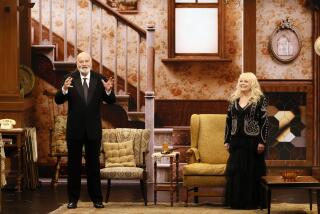Goodbye, ‘House of Cards’: Its ‘journey of reckoning’ comes to a close
In most cases, calling the arc of a recently ended series Shakespearean might be an overreach. But not for “House of Cards.” Over the course of six seasons, Netflix’s first foray into original programming gave us dark comedy and darker tragedy, transformed how we imagine the American political system, boosted the fortunes of its streaming network, introduced the concept of the first-run TV binge — and ended with a classic real-world twist that sent its lead actor down in flames, while its lead actress rose like a phoenix from the ashes.
“Looking back on the beginning of the show, there was ‘Macbeth,’ ‘Richard III’ — so many Shakespeare references in this series,” says Michael Kelly, who starred as political fixer Doug Stamper for the entire run. “You can get away with that when you have good writing.”
Which it always did, starting with original creator-showrunner, playwright Beau Willimon, who was replaced in Season 4 with senior writers Frank Pugliese and Melissa James Gibson, who always kept viewers guessing — and sometimes scandalized.
WATCH: 2019 Emmy Contenders video series »
“It was a show where you questioned the limits of these characters and the world in which they were inhabiting,” says Gibson. “It was about what can be gotten away with.”
And much was gotten away with, indeed. “Cards” was adapted from U.K. television, where three novels by Michael Dobbs had become three miniseries about the ambitious, ruthless Francis Urquhart as he rose to prime Minister. In making the jump across the pond, the focus turned to the U.S. government, and Urquhart became South Carolina Rep. Francis Underwood, played by Kevin Spacey.
The depth of talent behind and in front of the camera was undeniable, from two-time Oscar winner Spacey to Robin Wright (Underwood’s wife Claire), Kelly as Underwood’s right-hand man, future Oscar winner Mahershala Ali; and future “Mrs. Maisel” Rachel Brosnahan. Willimon had made waves in 2011 when his “Farragut North” play had been adapted into the George Clooney feature “Ides of March,” while David Fincher was set to executive produce.
All catnip to Netflix, which outbid such players as HBO and Showtime to spend a reported $100 million for 26 episodes.
“In 2011, when we made the decision to commission ‘House of Cards,’ there was no premium content being made for the internet,” says Cindy Holland, Netflix vice president of original content, in an email. “Who better to do that for us than David Fincher? We realized that we could change that perception, and the reality, with this one project.”
Netflix also made the then-innovative decision to release each season’s episodes simultaneously when it launched in 2013, which led fans to binge multiple episodes (if not a full season), and set the standard for much of the network’s later original releases.
Meanwhile, Spacey’s dead-on take of a politician who could be both warm and folksy (like his British counterpart, Underwood frequently broke the fourth wall to speak directly to viewers) — and also able to push a young reporter in front of a subway train if he had to.
Wright’s Claire, who would also go on to become president during the run, was the dark horse. “During my first meeting with David Fincher, he said, ‘This is not going to be a conventional relationship between two powerful people,’ ” she recalls. “He said they are going to be partners in crime, and over the years she will unveil different layers of herself.”
As did Wright, who went on to executive produce (as did Spacey) and direct multiple episodes during her tenure.
The show was a water-cooler, buzzworthy success from the start in a fragmenting industry where such beasts were becoming rarer, ultimately scoring seven Emmys and two Golden Globes. But as in many Shakespearean tales, a turn came in the final act. In 2017, as production on the sixth season was already underway, Spacey was accused of sexual misconduct. Netflix severed ties with him, announcing that the final season would not feature the actor.
“The writers had nine episodes fully written, and the rest of the season mapped,” says Kelly. “They had to rewrite everything.” In addition, talks for a spinoff with his character Stamper were scrapped.
But with Spacey out (and Underwood killed off, off-camera), Claire ruled in that final season. “It was her turn,” says Pugliese. “It was going to be like that one way or the other — Frank on screen or not. It was totally intentional to come full circle.”
“It was a great gift, that show, in many ways,” says Wright, who says her career trajectory shifted once she’d been seen as the cool, tough Claire. “I got a call, ‘Oh, you have a part in “Blade Runner,” ’ which was something I’d never been offered before,” she says. “After 25 years of playing ‘the pained wife,’ it set a new standard.”
To Pugliese, the show is a “cautionary” tale. “It’s about how you can get blinded by how entertaining politics can be, and forget that there’s service and work that needs to be done,” he says.
“It’s a journey of reckoning and complicity,” adds Gibson. “Ideally, it makes us reflect on who we root for — in any context.”
More to Read
From the Oscars to the Emmys.
Get the Envelope newsletter for exclusive awards season coverage, behind-the-scenes stories from the Envelope podcast and columnist Glenn Whipp’s must-read analysis.
You may occasionally receive promotional content from the Los Angeles Times.






